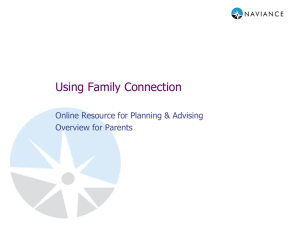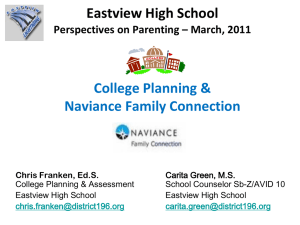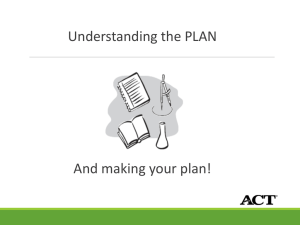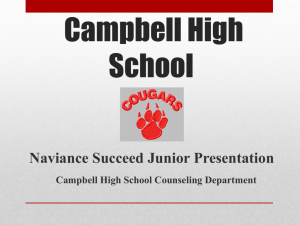Eastview High School POSTSECONDARY PLANNING & NAVIANCE Family Connection
advertisement
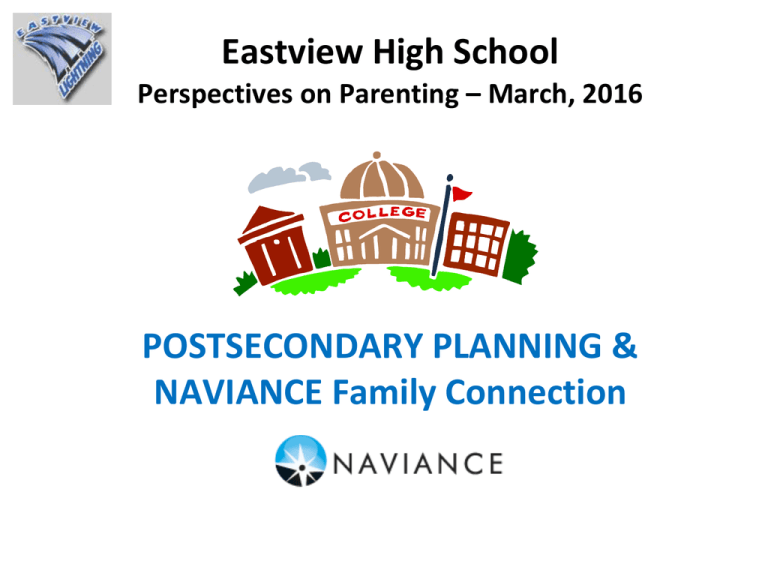
Eastview High School Perspectives on Parenting – March, 2016 POSTSECONDARY PLANNING & NAVIANCE Family Connection 2 Life after high school… Where do you want to be? 3 Engage in Self Reflection • • • • • • Recognize strengths and weaknesses Analyze interests and values Prepare for a career and expand learning Extracurricular activities and social life Influence of family and friends Consider personal goals 4 Post High School Options • • • • Community College Technical School Private Business School Military • Employment • Volunteer Work • 4 year college (private or public) 5 For every student to be prepared for the future, students, parents, teachers, and administrators must: ■ Begin planning high school courses in middle school ■ Systematically monitor student progress in those courses ■ Make timely interventions when students fall behind ■ Measure student progress regularly to ensure each student will meet or exceed college readiness standards 6 How College Is Different from High School • College is the first place where we expect young people to be adults. • The pupil-teacher relationship changes dramatically. • Expectations for engagement, independent work, motivation, and intellectual development also change. • College instructors pace their courses more rapidly, emphasize different aspects of material taught, and have very different goals for their courses. 7 An Operational Definition of College Readiness The level of preparation a student needs in order to enroll and succeed—without remediation— in a credit-bearing general education course at a postsecondary institution that offers a baccalaureate degree or transfer to a baccalaureate program. Conley, D. T. (2007). Toward a more comprehensive conception of college readiness. Eugene, OR: Educational Policy Improvement Center. 8 Twenty-one states’ definitions of “college and career readiness” mention concrete knowledge, skills, and dispositions that students must demonstrate mastery of to be prepared for postsecondary success. • Academic knowledge • Critical thinking and/or problem solving • Social and emotional learning, collaboration, and/or communication • Grit/resilience/perseverance • Citizenship and/or community involvement • Other additional activities: technology, lifelong learning, responsibility to environment and family Overview of State Definitions, American Institutes for Research, 2014 9 What Students Can Do to Develop Their College Readiness Students need: • to understand what it really means to be collegeready. • to understand what they must do as well as what the system requires or expects of them. • to understand that college admission is a reasonable and realistic goal that can be attained through planning and diligent attention to necessary tasks. 10 Students Also Need… • to construct an overall plan for college preparation that ensures they will develop the necessary skills in a progressively more complex fashion over four years. 11 Eastview High School Graduation Requirements • English - 4 years • Social Studies - 4 years • Math – 3 years • Science – 3 years • Physical Ed. - 5 quarters • Wellness - 3 quarters • Arts – one quarter course in visual arts, music, theatre, dance or interior design, advertising • Current gr. 10 & 11: MCA-III Reading, MCA-III Math test, ACT PLAN and ACT. 13 Admissions Requirements Technical & Community College • • • • • • English – 4 years Social Studies – 4 years Math – 3 years Science – 3 years No ACT Required May require a placement test (ACCUPLACER) 14 Admissions Requirements Traditional 4 Year College & Universities • • • • • • • • English- 4 years Social Studies- 4 years Math - 3 years (minimum level of Algebra II) Science- 3 years (minimum level - Chemistry) Foreign Language - 2 or more years Fine Arts – Recommend 1 year of fine or performing arts NCAA qualifications (if recruited athlete) ACT or SAT generally required 15 Admissions Requirements: Selective Colleges & Universities • • • • • • • • • English- 4 years Social Studies- 4 years Math- 4 years Science- 4 years Foreign Language - 3 years or more Fine Arts - one year of fine or performing arts Honors and Advanced Placement classes recommended Prefer 70th percentile and higher depending on selectivity ACT or SAT generally required – possibly SAT Subject Tests 16 What do colleges look for? Primary Measures – Rigor of Courses – GPA/Class Rank – ACT/SAT scores Secondary Measures – Application Essay – Recommendations – School Activities – Interview – Community Service 17 Course Titles and Grade Point Averages Clifford Adelman (2006) employed transcript analysis to reach the conclusion that completing a challenging high school curriculum is the greatest pre-collegiate indicator of bachelor’s degree completion. The nature and quality of the courses students take, and grades earned, are ultimately what matters. 18 Factors in the Admission Decision Percentage of colleges attributing different levels of importance to factors in the admission decision: 2011 19 Additional Factors 20 Tests…tests…tests… • Beyond using HS course titles to define college readiness, a more direct approach is to test a set of knowledge that students are presumed to need to know to succeed in college entry-level courses. (ACT/SAT) • Some colleges also rely on Advanced Placement (AP) test scores as a potential measure of college readiness. • All states have adopted some form of high school exam in English, Math and Science for a variety of reasons including requirements in the federal No Child Left Behind Act (now called the Every Student Succeeds Act – ESSA). Minnesota = MCA Reading, Math and Science 21 ACT Readiness Benchmarks for Entry-level College Courses ACT’s College Readiness Benchmarks are the minimum ACT test scores required for students to have a high probability of success in credit-bearing college courses— English Composition, Social Sciences courses, College Algebra, or Biology. 22 ACT Readiness Benchmarks for Entry-level College Courses ACT 1-36 (gr.11) English 18 English Composition Math 22 College Algebra Reading 22 Social Sciences Science 23 Biology 23 Class of 2015 Average Composite Score 21.0 National 22.7 MN 24.4 District 196 24.8 EVHS 24 Which College Entrance Exam? (Recommend taking in spring of Junior Year) ACT: SAT: (redesigned for Spring 2016) • Achievement test • Measures English, Math, Science and Reading • Scores can range from 1 – 36 • Optional Writing Test • Now focused on skills & knowledge • Measures evidencebased Reading and Writing; and Math • Scores range from 200 to 800 each section; 400-1600 total • Optional Essay (2 to 8)25 MN State & District ACT+Writing April 19th, 2016 • Minnesota juniors take the ACT Plus Writing test this year. • Minnesota Statute 120B.30, is intended to ensure all students are college and career ready. • Accepted by all US colleges (college reportable). • No pre-registration required & no cost for the 4/19 exam • Many ways to prepare: - February 24th ACT Practice Test - PrepMe Resource in Naviance Family Connection - www.actstudent.org practice test questions 26 ACT Practice Test @ EVHS! 27 - ACT prep resource in NAVIANCE Family Connection 28 EVHS ACT Prep Course (Under Academics) 29 Additional ACT/SAT Dates of interest to Current Juniors – Spring/Fall, 2016 ACT: • April 9 • June 11 • September 10 • October 22 • December 10 (3/5-18 late reg. deadline) (5/6 registration deadline) SAT: • May 7 • June 4 • October 1 • November 5 • December 3 ( 4/8 deadline) (5/6 registration deadline) 30 NAVIANCE Family Connection (Web-based Resource for College & Career Planning) Log into Family Connection through the Eastview Home Page. Look for Family Connection in the menu bar. You may also go directly to the login website: www.succeed.naviance.com/evhs 31 Students & Parents Create an Account with an E-mail & Password (click on “I need to register”) 32 Welcome to Your Home Page! (Check messages, college visits, web links and Access College, Career and About Me tabs) 33 Explore About Me Tab INTERESTING THINGS ABOUT ME • Game plan • Favorite colleges, careers • Resume • Surveys OFFICIAL THINGS • Profile • Account 34 • Test Scores •NAVIANCE Mobile App Create a Game Plan of Your Goals & College Interests 35 Build a Resume 36 Keep Track of Test Scores 37 Explore Careers Tab EXPLORE CAREERS • Favorite Careers & Clusters • Explore Careers & Clusters WHAT ARE MY INTERESTS? • Do What You Are – Personality Type • Cluster Finder – Career Assessment • Career Interest Profiler ROADTRIP NATION • Explore videotaped interviews of people who have built their lives around their interests. 38 EVHS Grade 10 Completed the Personality Type “Do What You Are” 39 EVHS Grade 11 Completed the “Cluster Finder” to Identify Top Career Clusters 40 Explore Additional Careers & Clusters & Save them in “My Favorite Careers” 41 42 43 Explore Colleges Tab MY COLLEGES • Colleges I’m Thinking About • Colleges I’m Applying to • Upcoming College Visits COLLEGE RESEARCH • College Searches •College Lookup • College Resources • College Maps • Scattergrams • Enrichment Programs SCHOLARSHIPS & MONEY • Scholarship List • Scholarship Match • Sallie Mae Nat’l Scholarship Search 44 Enrichment Programs Search by Alpha or by Topic Oodles of Information about Summer Programs & GAP Year Opportunities!!! 45 Factors to consider when choosing a college... • • • • • Cost College Characteristics Social Life Financial Aid Admissions Requirements • Academics • Student Population • Location 46 A Few Favorite College Search Tools NAVIANCE Family Connection: College Search & SuperMatch US Dept of Education: http://nces.ed.gov/collegenavigator/ College Navigator (access under links @ home page in FC) (Tutorial available on YouTube: www.youtube.com/watch?v=EVL08v3ZCz0 ) College Board: https://bigfuture.collegeboard.org/ Cappex: https://www.cappex.com/ Peterson’s: https://www.petersons.com/college-search.aspx 47 More useful sites! CSO College Center: www.CSOCollegeCenter.org KnowHow2Go: www.knowhow2go.org Hobson’s CollegeView: www.collegeview.com The Common Application Online: www.commonapp.org Colleges That Change Lives: www.ctcl.org Careers: MN’s career, education and job resource: www.iseek.org 48 Checklist for a Campus Visit • Meet with an Admissions Counselor • Verify Admissions Requirements and major deadlines (applications, financial aid) • Take a campus tour and attend a class • Investigate your academic program • Determine actual college costs • Talk with students and faculty • Discuss your chance for admission 49 Scheduled College Rep Visits on Family Connection INFORMATION & SIGN UP Students can sign up to visit with a college representative & receive an email reminder 50 College Lookup • Visit the School Website •Compare by GPA, Test Scores • Check Application History • Check EV Acceptance Rates • General Info, Admissions, Financial aid, Majors/Degrees, Student Life & MORE! 51 College Maps (Sample = 20 Most Popular Colleges for EVHS Students) 52 UMD – Satellite View! 53 Click on “Graph” to View Scattergram of Previous EVHS Applicants 54 District 196 College Fair: March 15, 4:00-6:00 Eastview High School Approximately 120 public and private colleges and universities, community and technical colleges, proprietary schools & military organizations will be represented. Participating colleges, trade, career schools and military organizations can be found on the website for MACAC at www.mn-acac.org. Go to “College Fairs”, then “For Students & Parents”. Admission to the college fair is free! 55 Lead Retrieval Technology: Scanners at District 196 College Fair Lead retrieval allows institutions to scan a barcode containing student information at a college fair. Go to www.gotocollegefairs.com, select the fair you will be attending, enter your personal information and print off your barcode. 56 College Rankings http://www.nacacnet.org/studentinfo/collegerankings/Pages/CollegeRankings.aspx 57 Build “Thinking about” List in Naviance Family Connection 58 Build Colleges I’m Applying to List Match Naviance account if using Common App! 59 Complete Required Survey if student needs a Counselor Recommendation Letter 60 Teacher Recommendations • • • • Not necessarily required by all colleges! Frequently required by Common App colleges Even if not required, may benefit a “bubble” candidate Complete teacher survey info. and request teacher through Naviance starting in September. 61 62 The Common Application A common, standardized first-year application form used by over 600 public and private colleges and universities. https://www.commonapp.org Minnesota Common App Colleges: Augsburg College Carleton College College of Saint Benedict Gustavus Adolphus College Hamline University Macalester College Saint John's University Saint Mary's University St. Catherine University St. Olaf College University of St. Thomas 63 The Coalition for Access, Affordability and Success • NEW application process involving 90+ member colleges/universities. • Goal is to improve the college application process and support disadvantaged students. • EVHS recommends class of 2017 use other application processes… (Common App, Colleges original online application, etc.) 64 Apply with each College’s own Online Application Process 65 College Costs Average Annual Tuition & Fees: From MN Office of Higher Education: http://www.getreadyforcollege.org • MN Private Colleges: $33,370 • University of MN-TC: $13,840 • MN State Universities: $7,999 • MNSCU 2-Yr Community, and Technical Colleges: $5,358 National Concern for College Affordability and Transparency 67 Net Price Calculators: Required by Federal Government http://collegecost.ed.gov/netpricecenter.aspx 68 College Scorecard http://collegecost.ed.gov/scorecard/index.aspx 69 U.S. Government College “Shopping Sheet” (Financial Aid Award Letter Standardized) 70 Costs and Financial Aid • FAFSA: Free Application for Federal Student Aid • Reciprocity: in-state tuition vs. out-of-state 71 Prior-Prior Year: FAFSA to open October 1st for Class of 2017 72 Benefits of Prior-Prior Year • File FAFSA starting October 1. • Use taxes from two years ago; already submitted to IRS. • Use IRS Retrieval Tool – easily import tax return. • Sync financial aid & college application calendars. • Remove barriers of priority filing deadlines – equal opportunity for consideration for funds. • Receive financial aid eligibility information in advance of college decision deadline – encourage more thoughtful and informed decisions. 73 FAFSA Determines Your Expected Family Contribution (EFC) Cost of Attendance - the EFC = FINANCIAL NEED 74 Eligibility Comparison (COA – EFC) Public Public Private 4-Year $15,000 - $ 5,000 2-Year $ 7,000 - $ 5,000 4-Year $25,000 - $ 5,000 Need of: Need of: Need of: $ 10,000 $ 2,000 $20,000 The Expected Family Contribution remains the same! 75 Financial Aid Package (compare financial aid shopping sheets) • Loans • Grants • Scholarships • Work Study 76 U.S. Consumer Financial Protection Agency Average student loan debt in U.S.: Approximately $30,000 Suggested total student loan debt: “Not much more than the starting salary of their new career.” Suggested % of income applied to student loans: 15% 77 Project on Student Debt http://ticas.org/posd/map-state-data-2015 78 EVHS Maintains a Scholarship List on Naviance Family Connection 79 School/Community Scholarships (SENIORS) Eastview Community Foundation Eagan Foundation Scholarship 80 http://www.ohe.state.mn.us/sPages/tptPayingForCollege.cfm 81 Where Can I Get More Information? • Federal Student Aid Info studentaid.gov • FastWeb Scholarship Search: www.fastweb.com • FinAid - The Financial Aid Information Page: www.finaid.org • Minnesota Office of Higher Education Student Website: http://www.ohe.state.mn.us/ 82 “Financing Education Beyond High School” An Introduction to Financial Aid Plan to attend the Eastview High School Perspectives on Parenting session on Financial Aid in 2016-17! 83 Navigating College Admissions: Tips for Parents • Encourage your child to be open-minded about college options. • Visit college campuses, but try to take a backseat. • Help your teen stay organized during the application process. • Talk about the cost of college, early and often. • Be optimistic, but prepare for rejection. • Listen, but know you can’t fix everything. Stacey Milton September 23, 2014 collegespecific How to Talk to Your Parents About College: Tips for Students 1. Ask yourself why you are applying to college in the first place. 2. Take ownership of your college process. 3. Your parents don't necessarily expect you to attend their alma mater. 4. Don’t shy away from difficult conversations. 5. Don’t be afraid to fail. 6. Define success on your terms. 7. Talk to your parents about how to talk to you. Eastview Counseling Staff 952-431-8914 Ms. Kelly Fisher A – Do Mr. Mark Wanous Dp – J Ms. Terri Greener/Ms. Beth Stoa K-O Ms. Anne Scholen P – S / AVID 10 & 12 Ms. Larinda Hodges T – Z / AVID 11 Ms. Chris Franken College Planning & Assessment/GT Ms. Pat Gerrits College Applications/Transcripts (x8914) Ms. Joan Mullaney Assessment/Scholarships (x8915) Ms. Cheryl Cross Registrar (x8913) 86 Summary of Resources: College/Career Planning • • • • • • • School Counselors Counseling Support Staff NAVIANCE Family Connection EVHS Career Center Internet Resources College Representatives Campus Visits 87 THANK YOU! Chris Franken, Ed.S. College Planning & Assessment Eastview High School chris.franken@district196.org 88
